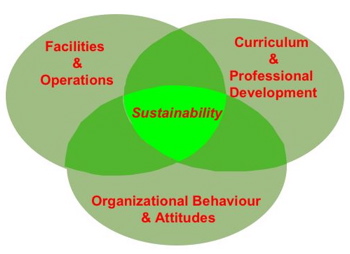School Greening
School greening means making sustainability for today's children and future generations the focus of curriculum and
professional development, facilities and operations,
and organizational behaviour.

When approaching the analysis with an open mind, it becomes clear: greening schools might be the most cost-effective path toward improving school performance. In fact, it might be the only educational achievement enhancing path that is also "profitable" (due to energy and operational cost benefits) even without considering the secondary (job creation, student / teacher health) and tertiary (pollution levels, capacity building for energy efficiency and other "green" across the country) benefits.
— A. Siegel
Greening your school means transforming all three aspects of your educational system:

Each aspect relates to a Green School goal:
- Ecological Literacy
(greening curriculum and professional development)
Every student and every teacher will develop a comprehensive understanding of the basic patterns and processes by which Nature sustains life, and how these ecological concepts relate to sustainable human communities.
- Learning It by Living It
(greening facilities and operations)
The school will green its facilities and adopt and demonstrate environmental principles such as the 3Rs (reduce, reuse, recycle), renewable energy, energy efficiency and resource conservation. This will allow for an experiential "place as pedagogy" teaching approach, and will enhance the environmental awareness of students and staff who see their school utilizing green practices on a day-to-day basis.
- Environmental Ethic (greening organizational behaviour and attitudes)
All members of the school community will develop a personal and collective code of responsibility to each other, the rest of Nature, the Earth, and future generations that entails constraints on individual conduct and institutional policies, and will apply this environmental ethic along with sustainable development principles when making decisions that affect the school.
School greening involves every member of a school community:
- students
- teachers
- administrators
- staff (secretaries, teaching assistants, cleaning staff, maintenance workers, school bus drivers, cafeteria workers, security guards, crossing guards, etc.)
- parents
- volunteers
- visitors (delivery people, guest speakers, attendees at school dances or athletic events, facilities renters)
- suppliers
- neighbours
- school board trustees
- Green School advisors or mentors

Schools can provide a healthy environment for students and staff, while promoting ecological sustainability, by using alternatives to toxic chemicals, pursuing green building and maintenance practices, changing their resource consumption patterns, serving nutritious food, and teaching students to be stewards of their communities, the Earth and its resources.
There is a tremendous opportunity — a grand teachable moment — for children to learn about ecological sustainability, environmental health, nutrition, personal responsibility, and leadership through their hands–on participation in making their own schools healthier, more efficient, sustainable, and pleasant centers for learning.
—
The Green Schools Initiative
How to get started?
The International Eco-Schools Programme and the Green Schools Initiative in the USA suggest seven steps for greening your school.
- Establish a Green School Committee, with representatives from as many sectors of the school community as possible, including students.
- Conduct an environmental survey or audit of your school (and, I would add, pretest the ecological literacy level of your students) to create a baseline or starting point so that all stakeholders will be able to see (and brag about) the results of your Green School projects.
- Create a Green School action plan, based on the results of the survey or audit. Start with the "low hanging fruit" — easily achievable targets — for short-term tangible results to be proud of. Set longer term goals as well, in each of the three areas:
- Monitor and evaluate progress through regular audits and updates, to ensure that goals are being met, and to gather data to inspire further action. (The data can then be used in math and other courses.)
- Integrate greening into the curriculum. Students learn what they live. Use the school as a hands-on laboratory for experiential learning, include greening activities into existing curricula, and look for transformative ways to incorporate sustainability learning into their educational program.
- Adopt an "eco code" or an environmental (or sustainability) vision statement, and create opportunities for everyone in the school community to see it and champion it often. Get the students to illustrate it.
- Inform, involve, and celebrate! Acknowledging, sharing and celebrating goal achievement is important for keeping motivation high (and motivating others). For example, implementing a Green School theme is a great way to get transformative education for sustainability off the ground. Use all available media to communicate your plan and your successes.
At one school where I worked, we invited student leaders and staff sponsors of environment clubs from neighbouring schools to an after-school Green Tea Party. We served organic teas, fruit and cookies, and invited a popular local school board trustee to be our keynote speaker of sorts. Then the students met and the teachers met (separately), and we got to share what our Green School program was doing — and be motivated by tales of success from the other schools.
Visit Seven Steps Towards an Eco-School for much more information.

Go to Greening the Curriculum
Go to Greening School Facilities
Go to Greening School Behaviour
Return from School Greening to GreenHeart Education Homepage



